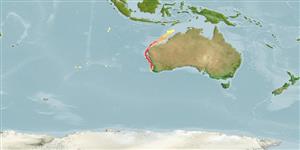>
Stomiiformes (Lightfishes and dragonfishes) >
Stomiidae (Barbeled dragonfishes) > Astronesthinae
Etymology: Eupogonesthes: Greek, eu = good + Greek, pogon = beard + Greek, esthes, -etos = cloth (Ref. 45335); xenicus: From the unique structure of the chin barbel and the intermediate position of the species between the genera Borostomias and Astronesthes ('xenos' = foreign, exotic)..
Environment: milieu / climate zone / depth range / distribution range
Écologie
marin bathydémersal; profondeur 200 - 600 m (Ref. 75891). Deep-water
Eastern Indian Ocean.
Taille / Poids / Âge
Maturity: Lm ? range ? - ? cm
Max length : 11.4 cm SL mâle / non sexé; (Ref. 41472)
Description synthétique
Morphologie | Morphométrie
Rayons mous dorsaux (Total): 10; Rayons mous anaux: 16; Vertèbres: 54. Body brown black; paired caudal fins not pigmented; dorsal and anal fins pigmented; adipose fin brilliant black. Chin barbel long, almost twice as long as the head, tapering to the end; with 2 glandular bulbs, the anterior one appearing as spindle-shaped expansion of the shaft which begins just behind the articulation with the chin and occupies nearly 1/3 of the length of the barbel; posterior bulb like a terminal proboscis of the barbel (Ref. 41472).
Found on the continental slope (Ref. 75154).
Life cycle and mating behavior
Maturité | Reproduction | Frai | Œufs | Fécondité | Larves
Parin, N.V. and O.D. Borodulina, 1993. A new mesobenthic fish, Eupogonesthes xenicus (Astronesthidae), from the eastern Indian Ocean. J. Ichthyol. 33(8):111-116. (Ref. 41472)
Statut dans la liste rouge de l'IUCN (Ref. 130435)
Menace pour l'homme
Harmless
Utilisations par l'homme
Plus d'informations
PaysZones FAOÉcosystèmesOccurrencesIntroductionsStocksÉcologieRégime alimentaireÉléments du régime alimentaireConsommation alimentaireRation
Noms communsSynonymesMétabolismePrédateursÉcotoxicologieReproductionMaturitéFraiRassemblement de ponteFéconditéŒufsDéveloppement de l'œuf
Taille/ÂgeCroissanceLongueur-poidsLongueur-longueurFréquences de longueursMorphométrieMorphologieLarvesDynamique des populations larvairesRecrutementAbondanceBRUVS
RéférencesAquacultureProfil d'aquacultureSouchesGénétiqueElectrophoresesHéritabilitéPathologiesTraitementNutrientsMass conversion
CollaborateursImagesStamps, Coins Misc.SonsCiguateraVitesseType de nageSurface branchialeOtolithesCerveauxVision
Outils
Articles particuliers
Télécharger en XML
Sources Internet
Estimates based on models
Preferred temperature (Ref.
123201): 10.3 - 14.6, mean 11.8 °C (based on 21 cells).
Phylogenetic diversity index (Ref.
82804): PD
50 = 1.0000 [Uniqueness, from 0.5 = low to 2.0 = high].
Bayesian length-weight: a=0.00417 (0.00171 - 0.01014), b=3.05 (2.83 - 3.27), in cm total length, based on LWR estimates for this (Sub)family-body shape (Ref.
93245).
Niveau trophique (Ref.
69278): 3.7 ±0.6 se; based on size and trophs of closest relatives
Résilience (Ref.
120179): Haut, temps minimum de doublement de population inférieur à 15 mois (Preliminary K or Fecundity.).
Fishing Vulnerability (Ref.
59153): Low vulnerability (10 of 100).
